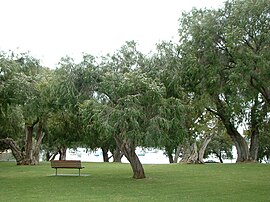Peppermint Grove, Western Australia
|
Peppermint Grove Perth, Western Australia |
|||||||||||||
|---|---|---|---|---|---|---|---|---|---|---|---|---|---|

Grove of Peppermint trees overlooking Freshwater Bay on the Swan River
|
|||||||||||||
| Coordinates | 31°59′56″S 115°46′05″E / 31.999°S 115.768°ECoordinates: 31°59′56″S 115°46′05″E / 31.999°S 115.768°E | ||||||||||||
| Population | 1,529 (2011 census) | ||||||||||||
| • Density | 1,390/km2 (3,600/sq mi) | ||||||||||||
| Established | 1830s | ||||||||||||
| Postcode(s) | 6011 | ||||||||||||
| Area | 1.1 km2 (0.4 sq mi) | ||||||||||||
| Location | 12 km (7 mi) SW of Perth CBD | ||||||||||||
| LGA(s) | Shire of Peppermint Grove | ||||||||||||
| State electorate(s) | Cottesloe | ||||||||||||
| Federal Division(s) | Curtin | ||||||||||||
|
|||||||||||||
Peppermint Grove is an affluent western suburb of Perth, Western Australia on the north bank of the Swan River at Freshwater Bay. It has been rated as Australia's most expensive suburb. Its local government area, the smallest in the country, is the Shire of Peppermint Grove. The suburb was named after its trademark "Peppermint trees" (Agonis flexuosa) lining many streets. The suburb has long been associated with Western Australia's wealthiest and oldest families: see Robert Pascoe's "Peppermint Grove: Western Australia's Capital Suburb". Their prosperity is reflected in historic houses in the area, such as 'St Just' and The Cliffe. Peppermint Grove remains, to this day, the suburb with the highest average weekly income in Western Australia. Its Sydney and Melbourne equivalents, as Pascoe points out, would be Vaucluse and Toorak. Colin Barnett, Premier of Western Australia, has dubbed the suburb "Australia's Monaco" due to its small size and concentration of wealth.
At the time of European settlement and for some years after, the area was thickly wooded with tuart, jarrah, red gum, banksia as well as the peppermint trees which gave the suburb its name.
In 1830, John Butler, an innkeeper, was given a grant of 250 acres (1 km²) on Freshwater Bay, after unsuccessfully attempting to secure land at Claremont. From this location, he operated "The Bush Inn", a stone house he had built and rigged out with native mahogany, commonly known as jarrah. After a series of arguments with the colonial authorities of the day, Butler left for Sydney in October 1835, but did not dispose of the property.
...
Wikipedia

